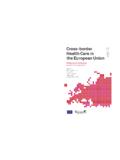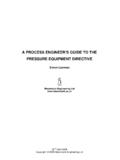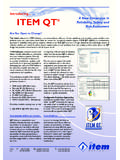Transcription of ECTS Users’ Guide - ec.europa.eu
1 ECTS Users GuideMore information on the european union is available on the Internet ( ).Cataloguing data can be found at the end of this : Office for Official Publications of the european Communities, 2009 ISBN: 978-92-79-09728-7 doi: european Communities, 2009 Reproduction is authorised provided the source is in BelgiumPr i n t e d o n w h i t e c h l o r i n e-f r e e P a P e rEurope Direct is a service to help you find answers to your questions about the european UnionFreephone number (*):00 800 6 7 8 9 10 11(*) Certain mobile telephone operators do not allow access to 00 800 numbers or these calls may be Users Guide Brussels, 6 February 2009 ECTS Users Guide4 ContentsIntroduction.
2 71. ECTS and the european Higher Education Area (Bologna Process)..92. ECTS key features ..113. ECTS key features explained .. ECTS as a learner-centred credit system .. ECTS and learning outcomes .. ECTS, levels and level descriptors .. ECTS credits and workload ..164. Implementing ECTS in higher education institutions .. ECTS credit allocation .. Awarding ECTS credits .. ECTS credit accumulation and progression .. Credit transfer in ECTS .. ECTS and lifelong learning ..235. Quality assurance and ECTS ..256. ECTS key documents .. Course Catalogue .. Student Application Form .. Learning Agreement .. Transcript of Records ..305 Contents7.
3 References for further reading .. Credit and qualifications systems .. Curriculum design .. Learning outcomes .. National publications ..338. Glossary ..35 Annex 1 Learners perspective in using ECTS ..37 Annex 2 Suggestions for institutions on recognition of periods of study abroad in the framework of bilateral agreements ..39 Annex 3 ECTS Grading Table ..41 Annex 4 Key documents ..45 Annex 5 Overview of national regulations on the number of learning hours per academic year ..59 ECTS Users Guide6 Introduction7 Introduction This ECTS Users Guide provides guidelines for implementation of the european Credit Transfer and Accu-mulation System (ECTS).
4 It also presents the ECTS key documents. The Guide is offered to assist learners, academic and administrative staff in higher education institutions as well as other interested 2009 Users Guide elaborates on the previous version of 2005. It has been updated to take account of developments in the Bologna Process, the growing importance of lifelong learning, the formulation of qualifi-cations frameworks and the increasing use of learning outcomes. It has been written with the help of experts from stakeholders associations and ECTS counsellors, and submitted for consultation to stakeholders as-sociations, Member States experts and the Bologna Follow-up Group.
5 The european Commission has coordi-nated the drafting and consultation process and is responsible for the final wording of the Guide . ECTS1 is a tool that helps to design, describe, and deliver programmes and award higher education qualifica-tions. The use of ECTS, in conjunction with outcomes-based qualifications frameworks, makes programmes and qualifications more transparent and facilitates the recognition of qualifications. ECTS can be applied to all types of programmes, whatever their mode of delivery (school-based, work-based), the learners status (full-time, part-time) and to all kinds of learning (formal, non-formal and informal).In the first section of the Guide , ECTS is placed in the context of the european Higher Education Area, created through the Bologna Process.
6 This section also refers to the role of ECTS in the Framework for Qualifications of the european Higher Education Area2 (referred to as the Bologna Qualifications Framework in this Guide ). The second section contains the ECTS key features. These constitute a concise overview of ECTS and its main functions, on which there is a broad consensus. The ECTS key features section is also available in a separate brochure. Section 3 provides a detailed explanation of the key features. Section 4 gives guidance on how ECTS can be implemented in higher education institutions, while section 5 discusses how ECTS complements institutions quality assurance tools. The final sections present the ECTS key documents, suggestions for further reading on topics related to ECTS and a glossary of the terms used in this Users Guide .
7 1 ECTS was originally set up in 1989 as a pilot scheme within the framework of the Erasmus programme in order to facili-tate the recognition of study periods undertaken abroad by mobile students. 2 Bologna Working Group on Qualifications Frameworks (2005) A Framework for Qualifications of the european Higher Education Area; Users Guide891. ECTS and the european Higher Education Area (Bologna Process)ECTS is the credit system for higher education used in the european Higher Education Area, involving all countries3 engaged in the Bologna ECTS is one of the cornerstones of the Bologna Most Bologna countries have adopted ECTS by law for their higher education other objectives, the Bologna Process aims at the establishment of a system of credits as a proper means of promoting the most widespread student ECTS contributes to several other Bologna objectives.
8 ECTS credits are a key element of the Bologna Framework for Qualifications,7 compatible with the european Qualifications Framework for 3 In some countries national or institutional systems exist alongside ECTS. 4 The Bologna process currently has 46 signatory coun-tries. For full list see: 5 Website of the Secretariat of the Bologna process Ben-elux 2009: Ibidem7 For further information see: lifelong learning (EQF).8 According to the Bologna Qualifications Framework, the first and second cycles have their own credit ranges (see section ). Consequently, ECTS credits are used in for-mulating national qualifications frameworks for higher education, which may contain more de-tailed national credit arrangements.
9 ECTS helps institutions to implement the objec- tive of quality assurance (see section 5). In some countries ECTS is a requirement for accreditation of higher education programmes or qualifications. ECTS is also increasingly used by institutions in other continents and thus plays a role in the grow-ing global dimension of the Bologna Recommendation of the european Parliament and of the Council on the establishment of the european Qualifica-tions Framework for lifelong learning ( ), 2008. The three levels of the Bologna Framework and the sub-level for the short cycle correspond to levels five, six, seven and eight of EQF for the higher education sector.
10 ECTS and the european Higher 1. Education Area (Bologna Process)ECTS Users Guide10112. ECTS Key featuresECTSECTS is a learner-centred system for credit accumu-lation and transfer based on the transparency of learning outcomes and learning processes. It aims to facilitate planning, delivery, evaluation, recognition and validation of qualifications and units of learning as well as student mobility. ECTS is widely used in formal higher education and can be applied to other lifelong learning creditsECTS credits are based on the workload students need in order to achieve expected learning out-comes. Learning outcomes describe what a learner is expected to know, understand and be able to do after successful completion of a process of learning.
















